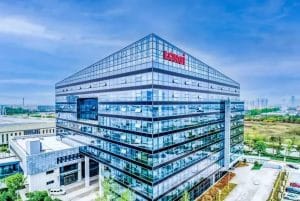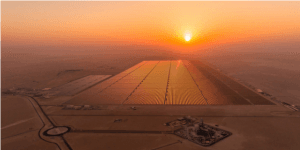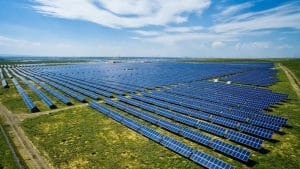Silicon material
This week’s silicon material price: the mainstream transaction price of single crystal recycled material is 34 yuan/KG, and the mainstream transaction price of single crystal dense material is 32 yuan/KG; the N-type material is quoted at 38 yuan/KG.
Trading situation: Trading sentiment this week is relatively flat; some polysilicon manufacturers have reported price increases, with the increase in the range of 0-1 yuan, but the downstream crystal pulling factories have limited acceptance of price increase orders under the background of their own unsmooth price increase, so the transaction volume during the week is low; it is difficult for upstream and downstream to reach a consensus on transaction prices.
Production scheduling: This month, the company’s production schedule will be further reduced to avoid further increase in losses; if the subsequent cash pressure is further aggravated, it is not ruled out that further reduction and suspension of production will be promoted, and the situation of strong players in the silicon material link will intensify. This month’s production schedule remains around 130,000 tons, with a slight downward revision from the previous month.
Inventory dynamics: Polysilicon inventory remains stable, and the weekly water level remains at 200,000-220,000 tons. Under the dual effects of the leading companies’ active production cuts and downstream pull-ups, granular silicon inventory is on a downward trend. There is still a certain gap between supply and demand for silicon materials this month, and it is expected that the inventory level at the end of the month will still face certain upward risks.
Price trend: Prices remained stable this week, and material companies have a strong willingness to increase their quotations, but high inventory and redundant existing production capacity still put great pressure on price increases. It is expected that in the short term, the main strategy for regulating production scheduling and stabilizing inventory in the silicon material link will still be to reduce load + force small and medium-sized factories to clear out. The success of silicon wafer price adjustment may be the key to realizing the increase in silicon material prices.
Silicon wafers
This week’s silicon wafer prices: The mainstream transaction price of P-type M10 silicon wafers is 1.15 yuan/piece; the mainstream transaction price of P-type G12 is 1.65 yuan/piece; the mainstream transaction price of N-type M10 silicon wafers is 1.08 yuan/piece; the mainstream transaction price of N-type G12 is 1.50 yuan/piece; the mainstream transaction price of N-type G12R silicon wafers is 1.25 yuan/piece.
Production scheduling: This month’s production schedule is adjusted down to the 49-50GW range, and it is expected to fall at the bottom of the range. The leading specialized manufacturers have made a great contribution to the reduction in volume, and the other specialized manufacturers have also slowed down their output to varying degrees. The consensus of silicon wafer manufacturers to reduce production and support price increases has increased. In addition, P-type silicon wafers have been further cleared, and the monthly output of N-type accounts for nearly 90%.
Supply and demand dynamics: Against the background of continued high losses, the synchronization rate of production scheduling decisions among silicon wafer leaders has increased, and they are determined to promote the process of reducing production and destocking; this month’s silicon wafer supply and demand gap has turned negative for the first time this year. From the demand point of view, the cell segment is affected by the unclear visibility of component orders, and the demand is also shrinking; at the same time, under the background of cell prices under pressure, enterprises are generally not very receptive to the increase in silicon wafers, and they are temporarily focusing on inventory digestion to delay the process of cost-side increase. Therefore, whether the consensus among manufacturers on production cuts and price increases can be maintained for a long time to cover the time required for inventory liquidation will be the key to the success of this round of price increases in the short term.
Price trend: Silicon wafer prices remained stable this week, and the upstream and downstream were slightly stalemate in the price game; some silicon wafer factories insisted on shipping at the increased price, while cell factories believed that accepting it would face the risk of increased losses. Looking at the market outlook, silicon wafers will still be consolidated and tugged.
Cells
This week’s cell prices: The mainstream transaction price of M10 cells is 0.290 yuan/W, the mainstream transaction price of G12 cells is 0.290 yuan/W, the mainstream transaction price of M10 monocrystalline TOPCon cells is 0.275 yuan/W, and the mainstream transaction price of G12 monocrystalline TOPCon cells is 0.280 yuan/W.
Supply and demand dynamics: Cells are facing the dilemma of being under pressure from both sides. This month’s supply was affected by the increase in production of a certain professional leader, and the overall production schedule has a slight upward trend, and the output of N-type cells is slightly redundant. On the demand side, component manufacturers generally face the problem of insufficient orders, so the demand support for cells is limited; at the same time, the components themselves are also constantly involuted, and the ex-factory prices of some leading manufacturers have been revised down this week. The dilemma of the cell link is that the upstream continues to lose money, so the willingness to report an increase is getting stronger, but the component end is under the pressure of involution and it is difficult to accept the cost increase. Professional cell manufacturers have weak bargaining power with downstream companies and cannot smoothly shift the pressure on the cost side downward.
Price trend: This week, the price of battery cells remained stable. Under the pressure of unstable downstream order demand and strong upstream price increases, some manufacturers may further reduce or stop production due to deteriorating profit conditions within the month. However, at present, the pressure brought by the cost increase in the short term is difficult to transfer through price increases.
Components
This week’s component prices: 182 monofacial monocrystalline PERC components are priced at 0.71 yuan/W, 210 monofacial monocrystalline PERC components are priced at 0.73 yuan/W, 182 bifacial double-glass monocrystalline PERC components are priced at 0.72 yuan/W, 210 bifacial double-glass monocrystalline PERC components are priced at 0.74 yuan/W, 182 bifacial double-glass TOPCon components are priced at 0.76 yuan/W, and 210 bifacial double-glass HJT components are priced at 0.90 yuan/W.
Supply and demand dynamics: The production schedule of components in September is in the range of 46-47GW. If the demand remains stable within the month, it will fall at the top of the range. At present, except for some manufacturers with good demand and low-to-mid-double-digit production schedule increases, the rest of the manufacturers are facing the problem of insufficient order demand, and generally reduce overall output. Discontinuous orders have become a new trend. The demand for overseas local manufacturing to cover local demand continues to impact domestic production.
Price trend: This week, the prices of various types of components remained stable; some leading manufacturers lowered their quotations (about 0.01-0.03 yuan/W), and began to adopt a price-for-volume strategy. Affected by the sluggish demand for distributed power, the spot prices of some large distributed power manufacturers tended to break through 0.70 yuan/W.
Photovoltaic glass
This week’s photovoltaic glass price: the mainstream transaction price of 2.0 mm coated photovoltaic glass is 13.00 yuan/㎡, and the mainstream transaction price of 3.2 mm coated photovoltaic glass is 22.00 yuan/㎡.
Supply and demand dynamics: The number of photovoltaic glass manufacturers who have cold repairs and blocked kiln mouths has increased, and the production capacity is shrinking. The supply will continue to decline within the month. From the demand side, the internal volume of downstream component factories continues, and they mainly digest their own inventory. The monthly output is difficult to cover the monthly photovoltaic glass supply, resulting in an upward trend in the inventory level of photovoltaic glass, setting a new high for the year.
Price trend: The price of photovoltaic glass is affected by the dual influence of the exhaustion of supply and demand relations and the rise in inventory levels, and the price has been adjusted down again. The transaction price of 2.0mm coated photovoltaic glass fell by 3.70% to 13.0 yuan/㎡; while the transaction price of 3.2mm coated photovoltaic glass fell by 2.22% to 22.00 yuan/㎡.



